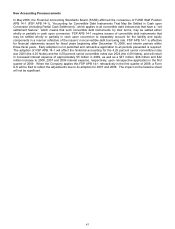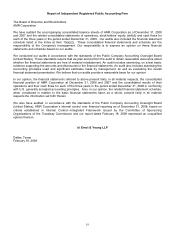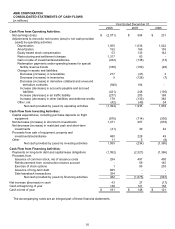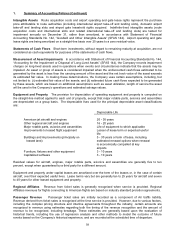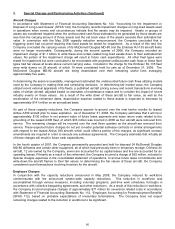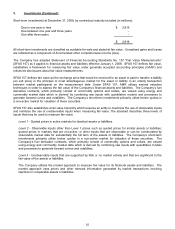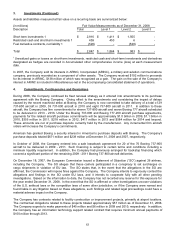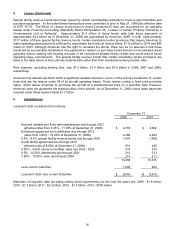American Airlines 2008 Annual Report Download - page 60
Download and view the complete annual report
Please find page 60 of the 2008 American Airlines annual report below. You can navigate through the pages in the report by either clicking on the pages listed below, or by using the keyword search tool below to find specific information within the annual report.
57
NOTES TO CONSOLIDATED FINANCIAL STATEMENTS
1. Summary of Accounting Policies
Basis of Presentation The accompanying consolidated financial statements as of December 31, 2008 and for
the three years ended December 31, 2008 include the accounts of AMR Corporation (AMR or the Company) and
its wholly owned subsidiaries, including (i) its principal subsidiary American Airlines, Inc. (American) and (ii) its
regional airline subsidiary, AMR Eagle Holding Corporation and its primary subsidiaries, American Eagle Airlines,
Inc. and Executive Airlines, Inc. (collectively, AMR Eagle). The consolidated financial statements as of and for the
years ended December 31, 2008, 2007 and 2006 include the accounts of the Company and its wholly owned
subsidiaries as well as variable interest entities for which the Company is the primary beneficiary. All significant
intercompany transactions have been eliminated.
New Accounting Pronouncements The Company has adopted Statement of Financial Accounting Standards
No. 157 “Fair Value Measurements” (SFAS 157) as it applies to financial assets and liabilities effective January 1,
2008. The Company’s routes are not yet subject to SFAS 157. SFAS 157 defines fair value, establishes a
framework for measuring fair value under generally accepted accounting principles (GAAP) and enhances
disclosures about fair value measurements. Fair value is defined under SFAS 157 as the exchange price that
would be received for an asset or paid to transfer a liability (an exit price) in the principal or most advantageous
market for the asset or liability in an orderly transaction between market participants on the measurement date.
The principal impact to the Company was to require the Company to expand its disclosure regarding its derivative
instruments and to consider credit risk as a part of the calculation of the fair value of derivatives, which was not
significant after consideration of collateral.
In March of 2008, the FASB issued Statement of Financial Accounting Standards No. 161, “Disclosures about
Derivative Instruments and Hedging Activities, an amendment of FASB Statement No. 133” (SFAS 161). SFAS
161 requires entities to provide greater transparency about how and why the entity uses derivative instruments,
how the instruments and related hedged items are accounted for under SFAS 133, and how the instruments and
related hedged items affect the financial position, results of operations, and cash flows of the entity. The
Company adopted SFAS 161 as of December 31, 2008. The principal impact to the Company was to require the
expansion of its disclosure regarding its derivative instruments.
In May 2008, the Financial Accounting Standards Board (FASB) affirmed the consensus of FASB Staff Position
APB 14-1 (FSP APB 14-1), “Accounting for Convertible Debt Instruments That May Be Settled in Cash upon
Conversion (Including Partial Cash Settlement),” which applies to all convertible debt instruments that have a ‘‘net
settlement feature’’, which means that such convertible debt instruments, by their terms, may be settled either
wholly or partially in cash upon conversion. FSP APB 14-1 requires issuers of convertible debt instruments that
may be settled wholly or partially in cash upon conversion to separately account for the liability and equity
components in a manner reflective of the issuers’ nonconvertible debt borrowing rate. FSP APB 14-1 is effective
for financial statements issued for fiscal years beginning after December 15, 2008 and interim periods within those
fiscal years. Early adoption is not permitted and retroactive application to all periods presented is required. The
adoption of FSP APB 14-1 will affect the historical accounting for the 4.25 Notes and the 4.50 Notes, and will result
in increased interest expense of approximately $5 million in 2009. Balance sheet impact is not significant.
Use of Estimates The preparation of financial statements in conformity with generally accepted accounting
principles requires management to make estimates and assumptions that affect the amounts reported in the
accompanying consolidated financial statements and accompanying notes. Actual results could differ from those
estimates.
Restricted Cash and Short-term Investments The Company has restricted cash and short-term investments
related primarily to collateral held to support projected workers’ compensation obligations.
Inventories Spare parts, materials and supplies relating to flight equipment are carried at average acquisition
cost and are expensed when used in operations. Allowances for obsolescence are provided - over the estimated
useful life of the related aircraft and engines - for spare parts expected to be on hand at the date aircraft are
retired from service. Allowances are also provided for spare parts currently identified as excess and obsolete.
These allowances are based on management estimates, which are subject to change.
Maintenance and Repair Costs Maintenance and repair costs for owned and leased flight equipment are
charged to operating expense as incurred, except costs incurred for maintenance and repair under flight hour
maintenance contract agreements, which are accrued based on contractual terms when an obligation exists.


